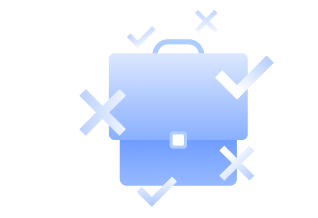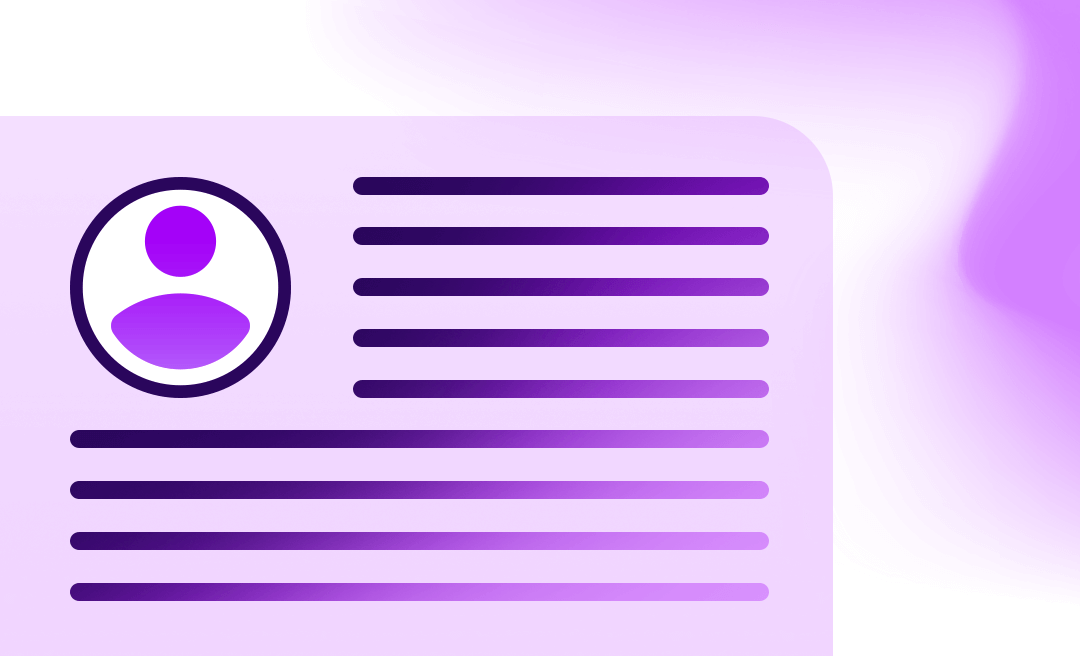From seeing AI as a tool to embracing it as a creative partner
Together with FR Media, we’re continuing our series of inspiring stories from tech experts about their journey into AI. Veronika Tryzna, Lead Business Analyst at EPAM, shares her experiences and vision for AI as a partner in innovation, a tool for radical transformation, and a collaborator that thrives on human insight.

“AI bridges potential and challenges, revolutionizing how we solve problems and scale solutions”
— While my title is Lead Business Analyst, my journey with AI has transformed my role into that of an AI Transformation Specialist — a bridge between AI's boundless potential and the tangible challenges businesses face every day. For more than a decade, I’ve worked on large-scale digital transformations and platforms, but delving into generative AI has truly reshaped my perspective from seeing technology as a tool to seeing it as a creative and supportive partner.
It all started with a challenge that felt almost insurmountable. I was working on a large-scale digital platform in the insurance industry, a sector steeped in tradition and complexity. We were facing processes that took months, involving immense manual effort and a high risk of human error. This was particularly true for insurance pricing. The question wasn't just “Can we do this better?” but “Can we fundamentally change the way this work is done?”
That question led me to my “aha” moment as the Product Owner for a GenAI Insurance Application. Our goal was to automate the creation of extremely complex pricing tables. Instead of just building another tool, we built a GenAI solution that could understand the intent behind the pricing rules and generate the tables with incredible precision. I started with a small proof-of-concept, using a flexible AI workbench that allowed for safe experimentation with different models. Watching AI co-create something that once took months of painstaking human effort and deliver it in a fraction of the time was the turning point. I saw firsthand that AI wasn't just about efficiency; it was about unlocking a new level of productivity and scale.
Another defining experience was the AI hackathon. Our team, the “Wadi Wizards,” came together with a shared passion for innovation. The energy was electric. My role was to serve as the prompt engineering expert, translating our user journey and epics into instructions that the AI could understand. The real challenge, and the moment of triumph, was wrestling with the LLM to generate responses in a perfectly structured JSON format while using RAG technology, which wasn’t very well-known at that time. When we finally cracked it, the developers were overjoyed, and the project came together. It was a powerful lesson in how human-AI collaboration thrives under pressure, blending business vision with technical execution.
This experience ignited a passion to share this potential with others. As an AI Productivity Expert, I began coaching business analysts, helping them move past their initial hesitation and see AI as a collaborative partner.
“It felt like it had understood the vibe”
— My most profound “wow” moment with AI was on a quiet weekend with my new hobby: vibe coding. For me, vibe coding is this incredible, creative process where you guide an AI to build functional code from natural language. It’s less about wrestling with syntax and more like a fluid, conversational dance with technology, allowing you to focus purely on your creative vision. I had an idea for a small, personal application and decided to build it with my AI partner, Claude Sonnet.
The process itself was exhilarating. I wasn't just writing commands; I was having a conversation. “Okay, Claude,” I'd start, “Let's design a clean, minimalist interface. I'm thinking of a single text box and a full-screen canvas for the visualization.” Instantly, the HTML and CSS appeared. “Great. Now, let's write the Python logic. It should understand the subtle patterns in my data that I might miss...” I explained, describing not just functionality but the soul I wanted the app to have. The back-and-forth was a creative whirlwind. I was the director, and the AI was my incredibly talented production team.
But the real, jaw-dropping moment came when I ran the finished application for the first time. In that instant, it hit me. The AI hadn't just processed my words; it felt like it had understood the vibe. It translated my abstract, human emotion into a tangible, digital reality that resonated back at me. It was the moment I truly saw AI not as a tool you command, but as a creative multiplier.
“The art of being a human-AI orchestrator”
— As AI becomes the new engine for execution, it’s easy to think our technical skills will become obsolete. But I believe the opposite is true. AI’s rise elevates a set of uniquely human abilities, shaping them into one master skill: the art of being a human-AI orchestrator. This isn't just one skill, but a symphony of a few that will define the next generation of innovators.
First, visionary leadership becomes paramount. If you can ask an AI to build almost anything, what matters most is no longer the “how,” but the “what” and the “why.” A leader's role shifts from managing tasks to setting a compelling vision. They are like the conductor of an orchestra filled with virtuoso AI performers.
Second, this requires radical flexibility and an open mind. AI is not a static tool; it's an evolving ecosystem. Thriving in this environment demands an explorer's mindset. You have to be willing to abandon old maps and processes that once brought success. You must have the humility to learn constantly and the courage to experiment.
Finally, and most practically, is the mastery of work choreography. This is the ability to organize the intricate dance between human talent and artificial intelligence. The key questions are no longer just “Who does what?” but “What is the perfect prompt, and who is best at crafting it?” and “How do we design a human-in-the-loop process to validate AI output?”. This is a new form of organizational design, a creative act of blending the strengths of human intuition with the power of machine intelligence.
“I dream of AI as a guardian of wellness”
— My vision for AI isn’t about flying cars or dystopian narratives. Instead, it’s deeply personal: a world where AI transforms healthcare into a proactive, personalized experience.
Imagine an AI co-pilot for your health, working silently in the background. It analyzes subtle data patterns — from sleep rhythms to genetic markers — and translates complex biological signals into actionable, easy-to-digest insights. For instance, a simple nudge to adjust your diet or a preemptive alert to visit a doctor before an issue escalates.
This isn’t science fiction. Tools like Retrieval-Augmented Generation (RAG) already enable real-time access to cutting-edge research, and large language models are capable of translating complexity into clarity. I believe these systems can help prevent chronic diseases early and make health expertise accessible to all. AI, in this vision, enhances — not replaces — human care with unique insights.
“You can’t drink from a fire hose: The rule of one”
— Staying confident in the AI workplace requires a mindset shift. I call it the “Rule of One”:
- One focus area: Instead of following every trend, I go deep into one subject, which builds expertise and confidence more effectively than scattered learning.
- One trusted source: With the overwhelming noise of information, sticking to one reliable AI news source keeps me informed without feeling overwhelmed.
- One experimental tool: I pick one favorite tool for pure experimentation — a personal AI sandbox. For me, that might be EPAM's DIAL platform or a specific model, such as Claude. This is my space to be curious and to learn by doing, without the pressure.
- One system for artifacts: Maintaining a consistent repository of project outputs sharpens my approach and reduces inefficiencies.
Most importantly, collaboration is everything. When I work on GenAI tasks with colleagues, we exchange ideas, troubleshoot challenges, and celebrate triumphs together. Real confidence comes not from knowing everything but from embracing community and sharing the journey.
“Experimentation and rhythm keep creativity alive”
— Working with AI demands discipline to avoid distractions. On the one hand, it's a tool that can amplify creativity and productivity. On the other, it presents a fascinating playground of possibilities where hours can be lost without making real progress on a primary goal. Experience shows that staying focused and creative requires a mix of firm discipline and strategic flexibility.
Here are the approaches I rely on to maintain a balance between curiosity and productivity.
Use the timebox strategy to structure curiosity
To avoid getting caught up in endless exploration, I use a timebox strategy: setting a timer for 30 minutes of intentional experimentation. During this window, I allow myself guilt-free exploration, whether that involves testing new features, tweaking prompts, or diving into creative tangents. When the timer goes off, I shift back to the primary goal. This small ritual strikes a perfect balance—it embraces curiosity while ensuring work stays on track.
Switch AI models to break through creative blocks
Another tip I’ve learned is knowing when to switch AI models. Hitting a wall with one LLM (Large Language Model) can feel like a dead end, but it’s rarely the idea itself that’s the issue. More often, it’s a mismatch with the specific strengths of the model you’re using.
Instead of forcing an approach that isn’t working, I simply change the lens by trying the same prompt in a different AI environment. For example, moving from GPT to Claude can yield dramatically different outputs—even with identical instructions. This strategy often breaks through creative blocks instantly, highlighting the strengths and unique capabilities of each platform.
Together, these two habits create a productive rhythm. The timebox provides focus, and the flexibility to switch models provides creative fuel. It’s how one stays in control, guiding the AI with purpose, rather than being led by its infinite potential.
“Stories are puzzles about human spirit and connection”
— When it comes to movies, I love psychological mazes like A Beautiful Mind or David Fincher’s work, which explore human complexity through intricate systems. On the other hand, life-affirming films such as the French masterpiece The Untouchables (1+1) leave a lasting impact. While it’s not a thriller, it solves a different kind of puzzle. With humor and heart, it shows that human connection is often the key to overcoming life’s seemingly insurmountable challenges. It’s a testament to the resilience of the human spirit.
This fascination with human-centric puzzles drives my love for medical dramas and TV series. At their essence, these are urgent detective stories, with the human body as the “crime scene.” A team of experts races against time to analyze symptoms, form hypotheses, and uncover solutions. This process mirrors the analytical work I’m passionate about — blending reason and creativity with a drive to improve lives.
In many ways, this parallels what we’re doing with AI today. The goal is to teach it to understand the patterns in our world and our health to help us solve these very same puzzles on a massive scale.


_(1).png)
.png)